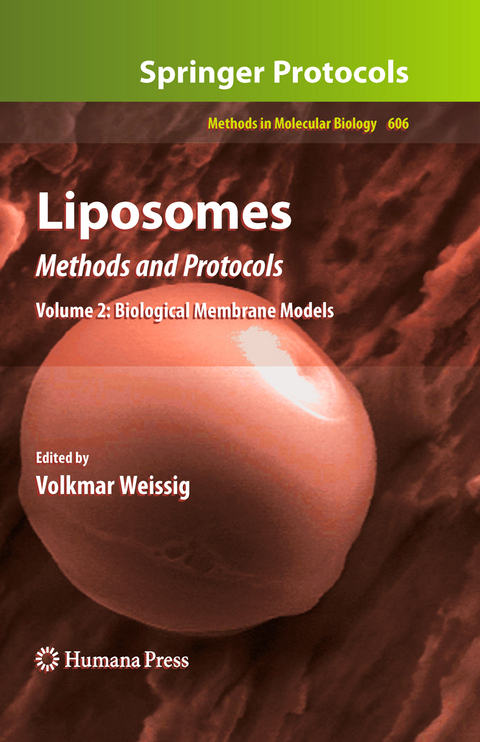
Liposomes
Humana Press Inc. (Verlag)
978-1-61779-687-6 (ISBN)
Utilization of Liposomes for Studying Drug Transfer and Uptake.- The Use of Liposomes in the Study of Drug Metabolism: A Method to Incorporate the Enzymes of the Cytochrome P450 Monooxygenase System into Phospholipid, Bilayer Vesicles.- Use of Liposomes to Study Cellular Osmosensors.- Studying Mechanosensitive Ion Channels Using Liposomes.- Studying Amino Acid Transport Using Liposomes.- Use of Liposomes for Studying Interactions of Soluble Proteins with Cellular Membranes.- Liposomal Reconstitution of Monotopic Integral Membrane Proteins.- The Reconstitution of Actin Polymerization on Liposomes.- Electroformation of Giant Unilamellar Vesicles from Native Membranes and Organic Lipid Mixtures for the Study of Lipid Domains under Physiological Ionic-Strength Conditions.- Visualization of Lipid Domain-Specific Protein Sorting in Giant Unilamellar Vesicles.- Biosynthesis of Proteins Inside Liposomes.- Study of Respiratory Cytochromes in Liposomes.- Use of Liposomes to Evaluate the Role of Membrane Interactions on Antioxidant Activity.- Studying Colloidal Aggregation Using Liposomes.- Assessment of Liposome–Cell Interactions.- Methods to Monitor Liposome Fusion, Permeability, and Interaction with Cells.- The Use of Isothermal Titration Calorimetry to Study Multidrug Transport Proteins in Liposomes.- Studying Lipid Organization in Biological Membranes Using Liposomes and EPR Spin Labeling.- Membrane Translocation Assayed by Fluorescence Spectroscopy.- Interaction of Lipids and Ligands with Nicotinic Acetylcholine Receptor Vesicles Assessed by Electron Paramagnetic Resonance Spectroscopy.- Environmental Scanning Electron Microscope Imaging of Vesicle Systems.- Freeze-Fracture Electron Microscopy on Domains in Lipid Mono- and Bilayer on Nano-Resolution Scale.- Atomic ForceMicroscopy for the Characterization of Proteoliposomes.- Method of Simultaneous Analysis of Liposome Components Using HPTLC/FID.- Viscometric Analysis of DNA-Lipid Complexes.- Fluorometric Analysis of Individual Cationic Lipid-DNA Complexes.- Fluorescence Resonance Energy Transfer-Based Analysis of Lipoplexes.- Analysis of Lipoplex Structure and Lipid Phase Changes.- Fluorescence Methods for Evaluating Lipoplex-Mediated Gene Delivery.- FRET Imaging of Cells Transfected with siRNA/Liposome Complexes.- Spectral Bio-Imaging and Confocal Imaging of the Intracellular Distribution of Lipoplexes.- Techniques for Loading Technetium-99m and Rhenium-186/188 Radionuclides into Pre-formed Liposomes for Diagnostic Imaging and Radionuclide Therapy.- Fluorescence Correlation Spectroscopy for the Study of Membrane Dynamics and Organization in Giant Unilamellar Vesicles.- Liposome Biodistribution via Europium Complexes.- Biosensor-Based Evaluation of Liposomal Binding Behavior.- Use of Liposomes to Study Vesicular Transport.
| Reihe/Serie | Methods in Molecular Biology ; 606 |
|---|---|
| Zusatzinfo | 7 Illustrations, color; 119 Illustrations, black and white; XVI, 548 p. 126 illus., 7 illus. in color. |
| Verlagsort | Totowa, NJ |
| Sprache | englisch |
| Maße | 178 x 254 mm |
| Themenwelt | Medizin / Pharmazie ► Medizinische Fachgebiete ► Pharmakologie / Pharmakotherapie |
| Medizin / Pharmazie ► Pharmazie | |
| Naturwissenschaften ► Biologie ► Biochemie | |
| Naturwissenschaften ► Biologie ► Genetik / Molekularbiologie | |
| Naturwissenschaften ► Biologie ► Mikrobiologie / Immunologie | |
| Naturwissenschaften ► Biologie ► Zellbiologie | |
| Schlagworte | biochemistry • Biological membranes • Biophysics • Cholestrol • Glycolipids • Lipids • Phospholipids |
| ISBN-10 | 1-61779-687-5 / 1617796875 |
| ISBN-13 | 978-1-61779-687-6 / 9781617796876 |
| Zustand | Neuware |
| Haben Sie eine Frage zum Produkt? |
aus dem Bereich


